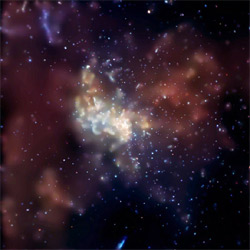An overview of the Chandra mission and goals, Chandra's namesake, top 10 facts.
Classroom activities, printable materials, interactive games & more.
Overview of X-ray Astronomy and X-ray sources: black holes to galaxy clusters.
All Chandra images released to the public listed by date & by category
Current Chandra press releases, status reports, interviews & biographies.
A collection of multimedia, illustrations & animations, a glossary, FAQ & more.
A collection of illustrations, animations and video.
Chandra discoveries in an audio/video format.
NASA's Chandra X-ray Observatory Marks Seven Years of Stunning Revelations
August 30, 2006 ::
Since 1999, a lot of things have come and gone -- the Y2K bug, a slew of boy bands and a new Star Wars trilogy. But NASA's Chandra X-ray Observatory, which unveiled its first images just a few months shy of the new millennium, continues to make headlines seven years later.
Maybe it's because Chandra's subjects are timeless -- black holes, distant galaxies, and stars that don't reside in Hollywood. And they're long-lasting -- with stellar lives that span billions of years. Or maybe it's because Chandra's amazing images are proof that truth is stranger than fiction.
Imagine a black hole gobbling up material in our own galaxy. In 2000, the Chandra Observatory captured such an event live. It observed for the first time a rapid X-ray flare coming from the direction of the supermassive black hole at the Milky Way's center. By capturing the violent flare in action, Chandra gave astronomers an unprecedented view of the energetic processes that surround our galaxy's hungriest inhabitant.
Now imagine not just one, but two black holes, sitting down for a celestial feast. In 2002, a Chandra image revealed, also for the first time, two active black holes in the nucleus of a galaxy called
NGC 6240, 400 million light years from Earth.
The discovery showed that massive black holes can grow through mergers in galactic centers. In fact, over the next few hundred million years, the two black holes -- now about 3,000 light years apart -- will drift together and merge, forming an even larger supermassive black hole with a more voracious appetite.
Chandra has also been used to take a sneak-peek at galaxies 10-billion light years from Earth -- contained in the most distant X-ray cluster of galaxies ever observed. Using Chandra, astronomers observed an hourglass-shaped region of X-ray emission surrounding a known radio source within the cluster. By confirming the radio source as the central galaxy in the massive cluster, astronomers are better able to understand what the universe was like at 20 percent of its current age. This is possible because it's taken 10 billion years for the X-rays, traveling at the speed of light, to reach Earth's vicinity. This means that Chandra, like a time machine, is peering back to a time when the universe was only two to four billion years old.
Speaking of age, Chandra recently helped astronomers verify the
Hubble Constant -- a critical number that tells us the universe's age, size, and how much matter it contains. How? By specifying the expansion rate of the universe at 76.9 in its traditional units of kilometers per second per megaparsec. A megaparsec is equal to 3.26 million light years. The Chandra result offered the independent confirmation that scientists had been seeking for year. In the process, the discovery helped fix the age of the universe between 12 and 14 billion years.
"Chandra's first groundbreaking images were unveiled in August 1999," said Chandra project scientist Dr. Martin Weisskopf of NASA's Marshall Space Flight Center in Huntsville, Ala. "A lot has changed since then, but Chandra continues to deliver new, exciting images that enhance our understanding of the nature and origin of our universe." Weisskopf should know. He's dedicated nearly three decades of his career to the Chandra X-ray Observatory Program, joining the observatory project in 1977.
Dubbed an engineering marvel when it launched, Chandra produces X-ray images 25 times sharper than previous X-ray telescopes. In spite of this, Chandra uses very little power. "The electrical power required to operate the Chandra spacecraft and its on-board instruments is just two kilowatts -- about the same power as a hair dryer," said Chandra Program Manager Keith Hefner of the Marshall Center. "Yet it delivers an average of 1,000 observations a year, shedding new X-ray light on some of the most powerful events in the universe."
Marshall manages the Chandra program for NASA's Science Mission Directorate in Washington. Northrop Grumman of Redondo Beach, Calif., was the prime development contractor for the observatory. The Smithsonian Astrophysical Observatory controls science and flight operations from the Chandra X-ray Center in Cambridge, Mass.
This feature courtesy of NASA/Marshall Space Flight Center/Steve Roy









